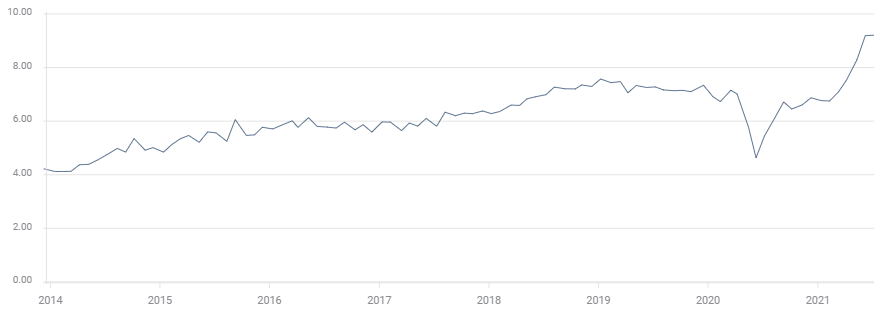- CPI expected at 0.5% in June, from 0.6%, annual at 4.9% from 5%.
- Core CPI forecast to gain 0.5% after 0.7% in May, yearly to 4% from 3.8%.
- Ebbing base effect will uncover shortage driven price gains.
- Markets will attend to CPI but not trade results.
Consumer prices in June are expected to provide the first proof that the recent sharp annual price gains are a temporary phenomenon.
Over the past six months the Consumer Price Index (CPI) has nearly tripled from 1.7% for the year in January to 5% in May. The core rate has gone from 1.4% to 3.8%.
In June, the monthly CPI increase is forecast to drop to 0.5% from 0.6% in May and 0.8% in April. The annual CPI rate is projected to slip to 4.9% from 5% in May. The April monthly increase and the May annual rate were the highest in over a decade.
Core inflation is expected to climb 0.5% in June, down from 0.7% prior and the annual rate is predicted to rise to 4% from 3.8%.
US CPI
Federal Reserve policy
Fed interest rate policy going back to the beginning of the pandemic, has been focused on restoring the job market and has been increasingly, and deliberately divorced from reaction to price increases.
The Federal Reserve began preparing for these unusually price steep increases last September when it adopted inflation averaging as a guide for policy. Under this system prices are permitted to run above target as long as necessary to bring the average into line with the 2% goal. The Fed has not set a period for inflation averaging.
However, even with the steep declines last year, the 12-month average for the annual core CPI rate was 1.84% in May. If the forecast of 4% for June is accurate the 12-month average will be 2.08%.
Lockdown prices and inflation
Last year's March and April lockdowns produced a collapse in consumer prices as households avoided all but essential purchases.That decline in the base index reversed as the economy reopened in the third and fourth quarters of 2020 and prices resumed their normal advances. The plunge in prices was most severe in April, May and June last year. Annual price gains of 0.3%, 0.1% and 0.6% respectively, resulted in the 4.2%, 5% and the expected 4.8% increases 12 months later.
The Fed’s assertion that this year’s exaggerated price gains are the product of the base effect was a mathematical certainty once price advances resumed. That part of the inflation equation has played out exactly as predicted.
This month's expected drop in the headline rate should be followed by further declines in the third and fourth quarters.
Labor and product shortages and inflation
Current inflation in the US is the product of more than base effect from last year’s price collapse.
The lockdowns wrecked havoc with supply chains and raw material production around the world. Almost all manufacturing is an assemblage of parts, material and labor from around the globe. Many of those components are in short supply, particularly the ubiquitous computer chips that are integral to so many consumer items. Shortages have driven consumer and producer prices higher and are not expected to relent until next year.
Labor is also in short supply in the US or at least the number of people willing to work is insufficient. The Job Openings and Labor Turnover Survey (JOLTS) had a record 9.2 million open positions in May. Help wanted signs are everywhere.
JOLTS
It is likely that for many lower wage jobs, the additional unemployment benefits enacted by the Biden administration are an incentive to postpone returning to work.
Employers are offering signing bonuses and wage increases to secure workers and these gains will remain once the labor shortage fades.
It is a matter of conjecture what portion of the current CPI rates are due to the base effect and what portion stems from the various shortages created by the economic closures. What is certain is that as the base effect wanes it will uncover higher residual inflation
Conclusion: Market response
The Federal Reserve has been successful over the last several months at reducing market sensitivity to inflation. The effort began with adoption of inflation averaging last September and has continued with the insistence that the current spike is temporary.
June is expected to be the first evidence that the Fed’s analysis is correct.
In a sense the Fed has been answering a question that the markets have never asked. There has never been any doubt that the rapid burst of inflation in the first half of was due primarily to the reversal of last year’s lockdown collapse.
The important and unanswered question is how much inflation has been created by the economic dislocation of the lockdowns? The answer to that query will not be known until the base effect is fully dissipated sometime in the fourth quarter.
Will core CPI return to its 2.3% average of the last quarter of 2019? Will the wage gains forced by labor shortages raise inflation expectations?
Market response to the June and subsequent CPI figures will be restrained until we begin to get an answer to those important questions.
Information on these pages contains forward-looking statements that involve risks and uncertainties. Markets and instruments profiled on this page are for informational purposes only and should not in any way come across as a recommendation to buy or sell in these assets. You should do your own thorough research before making any investment decisions. FXStreet does not in any way guarantee that this information is free from mistakes, errors, or material misstatements. It also does not guarantee that this information is of a timely nature. Investing in Open Markets involves a great deal of risk, including the loss of all or a portion of your investment, as well as emotional distress. All risks, losses and costs associated with investing, including total loss of principal, are your responsibility. The views and opinions expressed in this article are those of the authors and do not necessarily reflect the official policy or position of FXStreet nor its advertisers. The author will not be held responsible for information that is found at the end of links posted on this page.
If not otherwise explicitly mentioned in the body of the article, at the time of writing, the author has no position in any stock mentioned in this article and no business relationship with any company mentioned. The author has not received compensation for writing this article, other than from FXStreet.
FXStreet and the author do not provide personalized recommendations. The author makes no representations as to the accuracy, completeness, or suitability of this information. FXStreet and the author will not be liable for any errors, omissions or any losses, injuries or damages arising from this information and its display or use. Errors and omissions excepted.
The author and FXStreet are not registered investment advisors and nothing in this article is intended to be investment advice.
Recommended Content
Editors’ Picks

Gold falls amid a possible de-escalation of US-China tensions Premium
Gold pulled back from its all-time high of $3,500 per troy ounce reached earlier on Tuesday, as a resurgent US Dollar and signs of easing tensions in the US–China trade dispute appeared to draw sellers back into the market.

EUR/USD retreats to daily lows near 1.1440
EUR/USD loses the grip and retreats to the 1.1440 zone as the Greenback’s rebound now gathers extra steam, particulalry after some positive headlines pointing to mitigating trade concerns on the US-China front on Tuesday.

GBP/USD deflates to weekly lows near 1.3350
GBP/USD loses further momentum and recedes to the 1.3350 zone on Tuesday, or two-day troughs, all in response to the frmer tone in the US Dollar and encouraging news from the US-China trade scenario.

3% of Bitcoin supply in control of firms with BTC on balance sheets: The good, bad and ugly
Bitcoin disappointed traders with lackluster performance in 2025, hitting the $100,000 milestone and consolidating under the milestone thereafter. Bitcoin rallied past $88,000 early on Monday, the dominant token eyes the $90,000 level.

Five fundamentals for the week: Traders confront the trade war, important surveys, key Fed speech Premium
Will the US strike a trade deal with Japan? That would be positive progress. However, recent developments are not that positive, and there's only one certainty: headlines will dominate markets. Fresh US economic data is also of interest.

The Best brokers to trade EUR/USD
SPONSORED Discover the top brokers for trading EUR/USD in 2025. Our list features brokers with competitive spreads, fast execution, and powerful platforms. Whether you're a beginner or an expert, find the right partner to navigate the dynamic Forex market.

